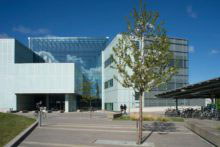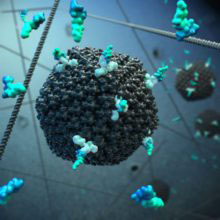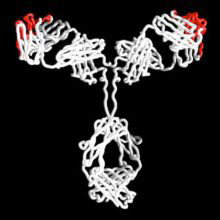Fast Facts

About the LMB
- The LMB is a leading international research centre and a prolific source of new ideas, discoveries and inventions.
- The LMB has been nicknamed ‘The Nobel Prize factory’: it has twelve Nobel Prizes for key discoveries and research undertaken here.
- Between 2012-17 the MRC will provide the LMB with almost £170 million in core funding.
- The LMB traces its origins back to 1947, when the Medical Research Council set up a 'Unit for Research on the Molecular Structure of Biological Systems'.
- The MRC Unit was established to allow Max Perutz and John Kendrew to develop their work using X-ray diffraction to study proteins.
- The first LMB building was opened in 1962, on the Addenbrooke's Hospital site. It was officially opened by H.M. The Queen on 28th May 1962.
The LMB Building

- The foundations for the new building comprise 885 load bearing reinforced concrete piles of average diameter 600 mm, sunk to depths of between 17 and 27 metres.
- The building was constructed of around 28,000m3 of concrete, with 2,500 tonnes of structural steelwork, 39,000m2 of cladding and around 10,000m2 of roofing.
- The building features a number of energy saving measures, including ground source heat pumps and heat recovery systems.
- The main laboratories are in 1000m2 modules, each housing 40 benchworkers together with write-up spaces, group leader offices and local equipment rooms.
- In overall structure the building is reminiscent of paired chromosomes, with two long laboratory areas joined by a spacious atrium.
- The building is at the heart of the expanding Cambridge Biomedical Campus, which has planning consent in place for a further 215,000 m2 of new biomedical research, development and clinical expansion space including the new Papworth Hospital and new headquarters for AstraZeneca.
- The new LMB building has a total building area of 32,772m2.
- The building cost over £200 million and was paid for, in part, from the royalties derived from antibody-related work carried out at the Laboratory.
- The LMB moved into a new, modern building in February 2013, on the Cambridge Biomedical Campus. It was officially opened by H.M. The Queen on 23rd May 2013.
Working at the LMB
- The MRC has well developed training programs available for all staff.
- The LMB is a full member of Travel for Cambridgeshire, dedicated to delivering and promoting sustainable and healthy travel to work.
- The Cambridge Biomedical Campus is well served by public transport with nearly 60 buses an hour on weekdays.
- Scientists are drawn to the LMB from all over the world: with over 50 different nationalities represented.
- The LMB has space to accommodate more than 600 people, with approximately 440 scientists and 160 support staff.
Current Research at the LMB

- Work carried out at the LMB on protein structure has increased our understanding of the malfunctioning proteins that cause illnesses, such as sickle cell anaemia.
- LMB scientists have identified abnormal protein deposits within nerve cells affected by Alzheimer’s and other neurodegenerative diseases. They are aiming to understand how to prevent or reverse this process.
- Research shows that antibodies can fight viruses from within infected cells. The discovery of this process is inspiring new types of antiviral drugs aimed at preventing or reducing infection.
- A new type of immune cell, that can initiate allergic asthma, has been found. The discovery of this nuocyte provides a critical first step in developing new strategies to treat allergic diseases.
- Studies on oocytes are revealing how errors in cell division during egg maturation can cause abnormal numbers of chromosomes. This is the leading genetic cause of miscarriage.
- Research by Venki Ramakrishnan’s group helped to solve the structure of the ribosome and is informing work to develop new antibiotics to combat infection and disease.
- The LMB has four internal research divisions – Cell Biology, Neurobiology, Protein and Nucleic Acid Chemistry, and Structural Studies.
- Research at the LMB is dedicated to understanding important biological processes at the molecular level – with the goal of using this knowledge to tackle major problems in human health and disease.
Past Research Achievements at the LMB
- César Milstein and Georges Köhler developed a technique to produce unlimited quantities of specific monoclonal antibodies, which helped to fuel an international billion-pound biotechnology industry.
- Aaron Klug developed 3D imaging at the LMB, helping to solve the structure of viruses and chromatin.
- John Kendrew and Max Perutz were the first scientists to determine the structure of a protein and their pioneering technique of protein crystallography, is used worldwide.
- Work on monoclonal antibodies, developed by César Milstein and Georges Köhler at the LMB, helped the development of therapies for rheumatoid arthritis, multiple sclerosis, cancers, viral infections and other diseases.
- At the LMB, Fred Sanger devised a technique to determine the sequence of the DNA bases - this method shaped research in genomics and biomedicine.
- Sydney Brenner, Bob Horvitz and John Sulston studied how genes regulate organ development and how cells are programmed to die. This is helping to inform our understanding of how viruses and bacteria invade cells, and how cancer changes them.
- Sydney Brenner and Francis Crick identified the triplet nature of the genetic code whilst working at the LMB. This discovery – that the order of the bases in a nucleic acid determines the order of amino acids in a protein – is one of the central biochemical mechanisms.
- Work carried out at the LMB to understand DNA has led to a range of medical breakthroughs, such as identifying ‘faulty’ genes.
- Francis Crick and Jim Watson helped unravel the structure of DNA – one of the scientific landmarks of the 20th century – in the MRC Unit
LMB Students and Postdocs
- Over 90% of LMB students publish their work, with an average of 3 publications per student.
- The LMB’s students come from a range of scientific backgrounds including mathematics, physics, chemistry and biology.
- 89% of LMB students continue in scientific or related careers, including academic postdoctoral positions, further professional training, the biotech industries and scientific administration.
- Around three-quarters of LMB students receive full or part funding from the MRC and about a quarter obtain highly competitive external studentships.
- More than 75% of LMB postdocs go on to further positions in research.
- The LMB has a great record in supporting students – over 95% who pass their probationary period go on to complete their PhD.
Technology Transfer and the LMB

- The LMB’s Richard Henderson and Chris Tate founded Heptares Therapeutics, in 2007, to exploit new technology to stabilise G-protein-coupled receptors. The company has raised more than £40 million from investors and signed drug discovery collaborations with AstraZeneca, Shire, Takeda and Novartis.
- Discoveries made at the LMB formed the basis of many early biotechnology companies, including Domantis, Cambridge Antibody Technology, Ribotargets, Protein Design Labs, Celltech, and Biogen.
- In addition to funding from the MRC, the LMB is also successful in attracting external funding from the EU, charities, other research councils and industry.
- Income from royalties and share sales arising from LMB patents amounted to over £700 million – enough to cover both the complete running costs of the LMB over the last five years and the cost of the new LMB building.
- LMB discoveries help fuel the UK’s life sciences industry – the third largest contributor to economic growth.
The “Nobel Prize Factory”
- 12 LMB Nobel prizes shared amongst 16 individuals:
- 2018 - Greg Winter (Chemistry)
- 2017 - Richard Henderson (Chemistry)
- 2013 - Michael Levitt (Chemistry)
- 2009 - Venki Ramakrishnan (Chemistry)
- 2002 - Sydney Brenner, Bob Horvitz & John Sulston (Physiology or Medicine)
- 1997 - John Walker (Chemistry)
- 1984 - César Milstein & Georges Köhler (Physiology or Medicine)
- 1982 - Aaron Klug (Chemistry)
- 1980 - Fred Sanger (Chemistry)
- 1962 - John Kendrew & Max Perutz (Chemistry)
- 1962 - Francis Crick & Jim Watson (Physiology or Medicine)
- 1958 - Fred Sanger (Chemistry)
- In 1962, the LMB was awarded 2 separate Nobel Prizes: Francis Crick and Jim Watson (Physiology or Medicine), and Max Perutz and John Kendrew (Chemistry).
- On 2 occasions a Nobel Prize has been awarded to a single LMB scientist and has not been a shared prize: Fred Sanger (1958) and Aaron Klug (1982).
- Fred Sanger was the first person to win 2 Nobel Prizes for Chemistry.
- 9 prizes in the field of chemistry; 3 in the field of physiology or medicine.
- 12 LMB Alumni have also received Nobel Prizes (LMB position and dates in italics):
- 2022 - Morten Meldal (Chemistry) Postdoctoral Visitor 1985-1986
- 2013 - Martin Karplus (Chemistry) Visitor 1969-1970
- 2013 - Arieh Warshel (Chemistry) Visitor 1974-1975
- 2012 - John Gurdon (Physiology or Medicine) Scientific Staff 1972-1983
- 2009 - Tom Steitz (Chemistry) Postdoctoral Fellow 1967-1970
- 2009 - Elizabeth Blackburn (Physiology or Medicine) PhD Student 1971-1974
- 2008 - Martin Chalfie (Chemistry) Postdoctoral Staff 1977-1982
- 2006 - Andrew Fire (Physiology or Medicine) Postdoctoral Fellow 1983-1986
- 2006 - Roger Kornberg (Chemistry) Postdoctoral Visitor 1972-1975
- 1993 - Richard Roberts (Physiology or Medicine) Visitor 1970, 1978-1979
- 1993 - Michael Smith (Chemistry) Postdoctoral Visitor 1975-1976
- 1989 - Sidney Altman (Chemistry) Postdoctoral Visitor 1969-1971
- The LMB has been nicknamed ‘The Nobel Prize Factory’. (Inside the Nobel Prize Factory. Steve Connor. The Independent on Sunday, 13 October 2002).